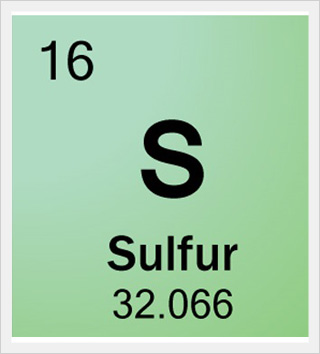This article is a companion piece to our GHS Hazard Classification compendium. It presents a case study on sulfur, emphasizing the importance of having multiple, reliable sources of chemical information to author your SDSs.

Using the wrong information in any situation could result in an inaccurate and dangerous SDS. Even the most common chemicals should be subjected to extra research.
Stopping at just one source of chemical information for any material when authoring your SDSs and labels is bad practice, even if its from a source you generally trust, like the Environmental Protection Agency. There is so much information available about the GHS classification system that there’s debate about certain chemicals... even between regulators and experts.
At ERA, we experienced this scenario firsthand when our team of experts went to work researching how to properly classify materials containing sulfur. Although data from the GHS guidelines classifies sulfur as having certain hazards, regulators in North America also classify it as having a different set of hazards.
Which should you use? Which governing body is correct? How will this impact your data sheet authoring?
Sulfur Case Study
The Chemical: Sulfur
Sulfur is an abundant, multivalent non-metal. It occurs naturally as a pure element. Today, most of elemental sulfur is produced as a byproduct of removing contaminants from natural gas and petroleum, and it is commercially used in fertilizers and in the production of sulfuric acid.
The Problem
According to the Classification Labelling and Packaging (CLP) regulation, sulfur is classified as Skin corrosion/irritation – Category 2. Upon further research, our expert scientists found that sulfur should be classified under Acute Toxicity Inhalation Category 4, Acute Toxicity Dermal Category 5, and Acute Toxicity Oral 5, in addition to its CLP classification.
Additional evidence from New Zealand's Chemical Classification and Information Database also suggests that sulfur can be classified as an Eye Irritant Category 2 and a Flammable Solid Category 2 in accordance with the Hazardous Substances and New Organisms (HSNO) regulations. Accordingly, the HSNO classification framework and control regulations were derived from recent international harmonization activities (the GHS).
Even though the GHS Purple Book specifies that Category 2 skin irritants are not necessarily eye irritants, this is subject to debate. Table 3.2.5 (page 137) from the GHS Purple Book shows that only category 1A, 1B and 1C are linked to eye damage because they are corrosive. Though not specified in the GHS guidelines, it is certainly possible that a chemical that causes simple skin irritation can also cause eye irritation.
Label Elements for Skin Corrosion/Irritation from the GHS Purple Book
There is some uncertainty with regards to the eye irritant potential and flammability of sulfur. However, this case study draws attention to the fact that hazard classification is not always black and white. And sometimes, companies need to make the most conservative judgment call based on the research available.
The Solution
By researching multiple chemical and toxicological databases, including Sigma Aldrich and the Registry of Toxic Effects of Chemical Substances (RTECS), our scientists were able to gather and compare MSDSs to see how sulfur was classified. Additional GHS Classification information is presented below:
Excerpt of Sulfur MSDS:
Acute toxicity, Inhalation (Category 4)
The decision logic for Acute Toxicity from the GHS Purple Book (pages 123-124) shows that according to the above researched LC50 and LD50 values for Sulfur, the element should be classified, according to worst-case scenarios, as Acute Toxicity Inhalation Category 4, Acute Toxicity Dermal Category 5, and Acute Toxicity Oral Category 5.
Note: The decision logic above is taken from an earlier version of the GHS Purple Book. It contains the same information as the current version but displays it in a continuous, easy-to-read diagram.
Key Take-away
Without proper cross-referencing, sulfur would have remained classified as a Category 2 Skin Irritant. While this is acceptable according to GHS, it does pose a risk to your employees.
If you do not communicate all of the dangers your materials present, your staff may find themselves injured or at risk without the necessary information to protect themselves or treat the exposure. And it’s your business that will be held responsible. A little extra research into other chemical databases can better guarantee a safer work environment, and one that presents less risk to your productivity.
When authoring your SDSs and labels, you must classify sulfur as a Category 2 Skin Irritant, but you should also classify it as an eye irritant as well as under Acute Toxicity Inhalation Category 4, Acute Toxicity Dermal Category 5 and Acute Toxicity Oral 5. Include the GHS hazards statements, precautionary statements, pictograms, etc. This is the best choice as it will ensure you are compliant with GHS regulations, increase on-site safety, and make your work easier if OSHA decides to modify or reclassify sulfur in the future.
Researching multiple sources and authoring the most comprehensive SDSs and labels is important to your success, but it also requires a great deal of time and effort if you don’t put a system in place to make the task more efficient. ERA’s SDS authoring software system lets you author GHS compliant SDSs and labels on the fly for any of your materials in just minutes - and it instantly references multiple databases to ensure you get the most reliable and comprehensive data possible. As this case study shows, we take getting you the best information possible seriously.
Ask an ERA Expert:
Do you have any questions or concerns about the topic covered in this article? Want more insight? Now is your chance to ask one of ERA’s Environmental Specialists. Please leave your question or comment below and we’ll make sure one of our expert scientists responds.Get the Ultimate GHS Hazard Classification Guide
This Blog was Co-Authored By:


May 23, 2014

Comments